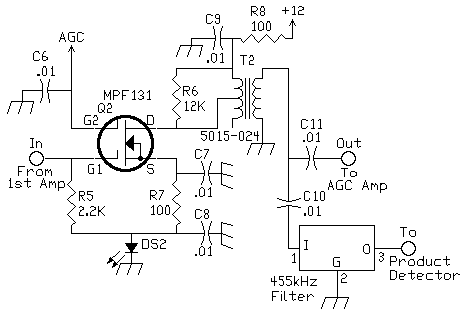



|
An inexpensive 6 kHz bandwidth 455kHz ceramic filter can be used between the Second IF Amplifier and the Diode Product Detector. This lowers the noise output of the IF amplifier strip. The one used in the receiver is the Murata SFU455A. ReferencesThe original inspiration for this IF strip came from the "Progressive Communications Receiver" in most of the recent ARRL Handbooks. That circuit is used at 9 MHz, uses two stages, and uses an LED (or two diodes in series) to raise the circuit ground of the MOSFETS. It is also a broadband circuit and could be used at any IF frequency given the limitation of the ferrite cores used. AGC performance falls with higher frequencies (10 mhz to 20 mhz), but works very well for 9 MHz and below. Another MOSFET IF strip worth looking at is "DX Receiver for the Ham Bands", by Ovi Florea, Ham Radio, December 1976, Page 10. His MOSFET amplifiers used a minimum of parts with 455 kHz Radio Shack cans, but does not reference the sources above ground, or use any 'oscillation tamers' (resistors across the output coil or ferrite beads) on the MOSFETS. I have found that when source resistors of 270 to 470 ohm are used (as in Florea's circuit), that the gain of the MOSFETS is considerably lower than when 100 ohm source resistors are used. This may be how he gets away without the "oscillation tamers".
|

Send E-Mail || Amateur Radio Receivers || Super Receiver || Super Receiver Circuit Details
